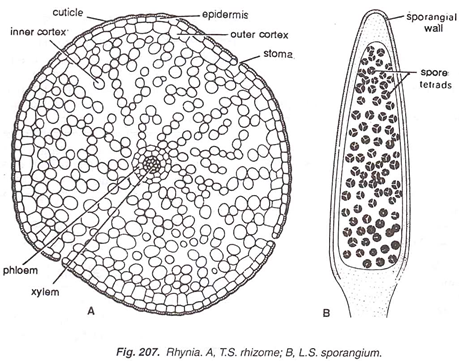ADVERTISEMENTS:
Study the external features and anatomy of different plant parts of rhynia from the permanent slides.
External Features of Rhynia:
1. Plant body was sporophytic.
2. Rhynia major was bigger and attained a height of 50 cm. with a diameter of 1.5 to 6 mm.,while R.gwynne-vaughani (Fig. 206) had a height of 20 cm. and a diameter of 1 to 3 mm.
3. Plants had a rhizome which was dichotomously branched.
4. From rhizone developed many dichotomously branched erect aerial shoots towards the upper side while many rhizoids towards the lower side.
5. There were no roots on the plants.
6. Aerial shoots of Rhynia major were smooth and devoid of leaf or any other outgrowth, while in case of R.gwynne-vaughani many adventitious branches were present on the aerial shoots.
ADVERTISEMENTS:
7. Aerial shoots were either ending into simple vegetative tips or having terminal sporangia.
Anatomy of Rhynia:
1. Rhizome and aerial shoots of the plant were internally differentiated into epidermis, cortex and stele (Fig. 207).
2. Stele was of a simple protostele type, (i.e., central column of xylem was surrounded by phloem).
3. Xylem was made up of only tracheids.
4. Phloem was 4 to 5-cells in thickness.
5. There was no endodermis in between cortex and stele.
6. Cortex was differentiated into outer and inner cortex, and was about 10 times more in thickness than stele.
7. The inner cortex was made up of many spherical cells having large intercellular spaces.
ADVERTISEMENTS:
8. The outer cortex was one to four cells in thickness and without any intercellular spaces.
9. Outermost layer was one-celled thick epidermis with a thick cuticle.
10. Continuity of epidermis was broken by many stomata.

